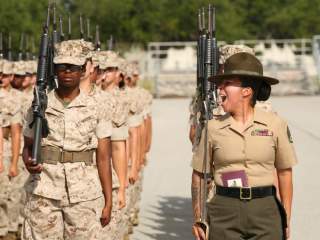Women in Combat: Getting the Facts Right First
Data, science and the law should drive implementation.
While the focus here has been on physical fitness tests, physical abilities are not the only factor in making a or assessing a combat specialist. For example, Lieutenant General Gregory Newbold, USMC (Retired), wrote an op-ed highlighting some of the mental and emotional requirements of combat and concluded that women should not be integrated into combat roles as only our young men can endure the chaos of armed combat. However, he provides no data or scientific evidence to support his conclusion that women lack the mental and emotional strength and fortitude required. Importantly though, the methodologies discussed here generalize. And just as with physical requirements, any standard should be evaluated with sound research and in accordance with legal requirements. Until a test of the required mental capacity for combat exists, mentally unsuitable candidates cannot be screened regardless of gender. Once such a test exists, it can be applied to both men and women equally.
Where Are We Now?
After a gender-integrated pilot program in which three women successfully completed the elite Ranger training, the Army permanently opened the training to all qualified soldiers. Similarly, the Marines opened their Infantry Officer Course and enlisted Infantry Training Battalion. A woman has yet to pass the officer course, however a third of women who attempted passed the enlisted course. Senior members of the Navy have stated that the elite Navy SEALs will be open to women who can pass their grueling six-month Basic Underwater Demolition/SEAL training.
On February 2, senior officials from the Army, Navy and Marines outlined their integration plans to the Senate Armed Services Committee, and all agreed that this is “the right path for the future.” Since then Secretary of Defense Ash Carter approved the services’ implementation plans. In his announcement he emphasized that transparent, up to date, and operationally relevant standards are paramount. Claiming standards are good enough without data-driven, scientific evidence is no longer acceptable.
Of course it is not appropriate to allow every woman into combat, but neither is it appropriate to allow every man into combat roles for which they are physically unqualified. Using predictive and occupationally linked predictive fitness standards will ensure the physical preparedness of all combat troops (women included) and address the concerns of the 80 percent of special operators who fear female's physical limitations will degrade their combat readiness.
No one knows the outcome of the integration of women into combat roles. But, as we continue with implementation, we should follow the secretary of defense’s guidance using data, science and the law.
Katherine A. Batterton, Kimberly N. Hale, and Eric M. Murphy are operations research analysts for the United States Air Force. The conclusions and opinions expressed in this article are theirs alone and do not reflect the official position of the U.S. Air Force, Department of Defense, or the U.S. Government. This article first appeared in the Bridge.
Image: Flickr/U.S. Department of Defense.

